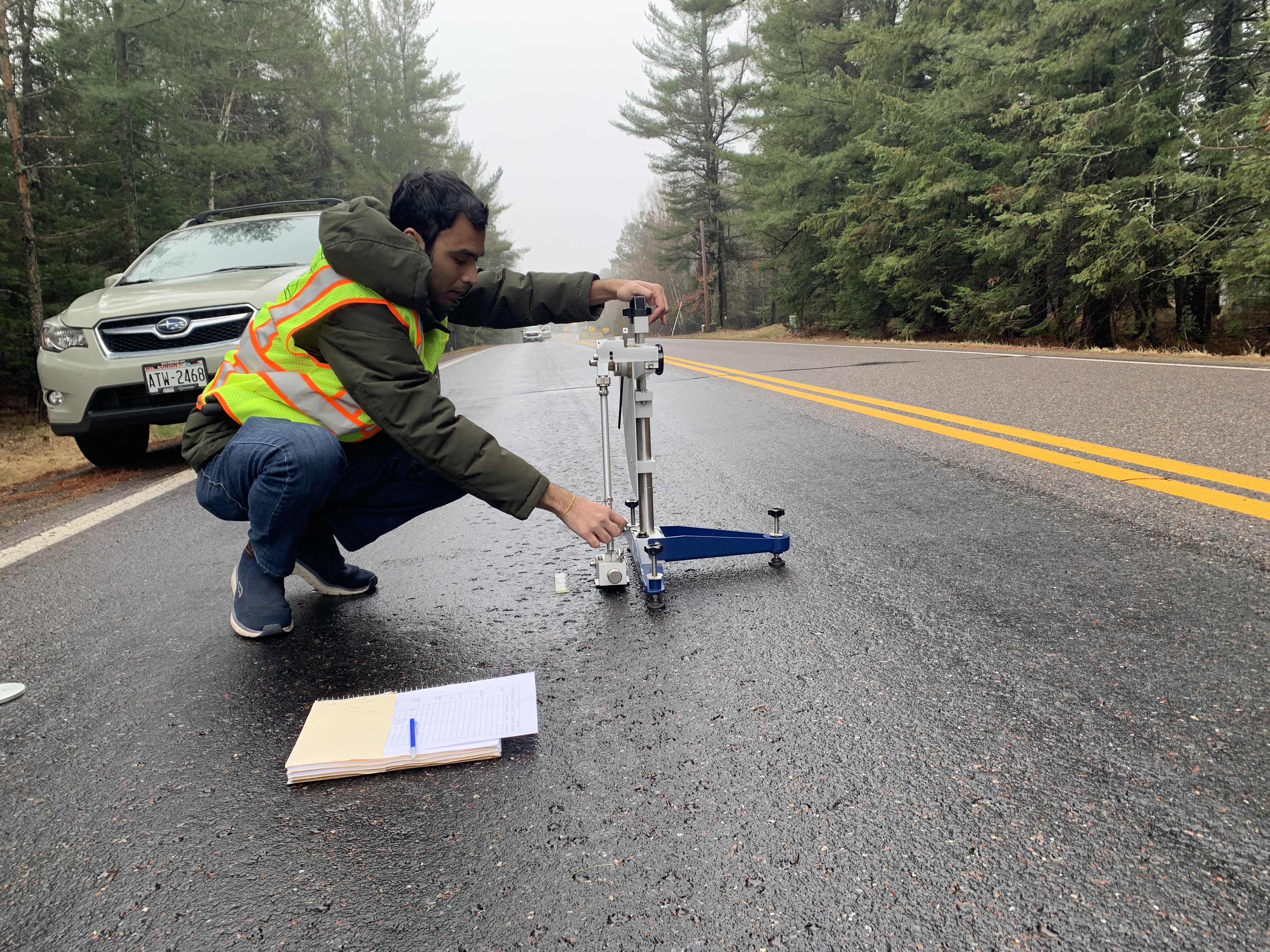A lot of planning, testing and innovation goes into something you might not even think about much – the road under your tires. Except, of course, when the surface is slick with rain or snow. Then, it’s all you can think about while driving.
Roads that need high friction to grip tires – interchange ramps, bridges, steep grades – are often surface-treated with calcined bauxite, a very hard, manufactured aggregate. China is a primary producer of calcined bauxite for road surfacing. Raw bauxite is a soft material with a high alumina content, but it’s made super hard by calcining (kiln-firing) at 3,000 degrees F and then shipped to the U.S. It works great (think sandpaper grit), but is obviously an expensive and energy-intensive product with a high carbon footprint.
So NRRI is testing a readily available Minnesota material against bauxite on a stretch of road near Duluth. The aggregate is already mined and sitting in waste piles on the Iron Range – taconite tailings. And after three years of testing, the taconite is holding its own as a high friction aggregate, but winning hand-over-fist in cost and energy efficiency.

“We did this side-by-side comparison, with untreated pavement, calcined bauxite-treated and four mixtures with taconite on about a mile-long stretch of road,” said Larry Zanko, recently retired NRRI geologist and now consultant on the project. “And that harsh winter of 2022-23 really tested it. We know that snowplows create the most wear on roads, and that winter there were about 100 snowplowing events.”
Meeting the Standards
Standardized ASTM friction testing equipment is used by Zanko and project lead Mihai Marasteanu, professor at the UMN Twin Cities Department of Civil, Environmental, and Geo-Engineering .
Twice a year, the researchers visually inspect the road surface. Then, the tools come out. A British Pendulum friction tester swings across the wetted road surface and measures how much the pavement surface slows the pendulum down, recording a friction number.
Another tool is reminiscent of an old record player – and about the same size. The Dynamic Friction Tester has a rapidly rotating disk that spins up to 40 miles per hour and is then dropped on wetted pavement. It measures how long it takes for the road surface to stop the spin.
A third test is a Minnesota Department of Transportation “skid trailer” fitted with full-scale tires. The trailer is pulled by a pickup truck and brought up to full speed -- 40 mph -- before the brakes are slammed on to measure skid resistance. Again, with water applied ahead of the tires to simulate a slick roadway.
“This is how all pavement testing is done, using ASTM standard methods,” explained Zanko. “So we’re putting our taconite road aggregate up against a standard surfacing material.”
What they’ve found is that the taconite tailings are performing very nearly as well as the calcined bauxite.
Life Cycle Analysis
NRRI Materials Scientist Matt Aro conducted a cradle-to-gate life cycle assessment to compare the taconite aggregate against bauxite for ecosystem and resource impacts.
Given that the taconite is already mined and crushed for the taconite pellet-making process, there’s already considerable energy savings. Optimal Aggregate LLC, which supplies the taconite, has built a business around gathering up the waste rock, drying it, screening it for size and bagging it. And, of course, it’s not shipped internationally.
According to the report, the comparative analysis showed that the taconite tailings-based friction aggregate had between 55 percent (Ecosystems) and 31 percent (Resources) fewer impacts than the calcined bauxite-based High Friction Surface Treatments across all impact categories. And when aggregate production alone is considered, the assessment showed that calcined bauxite’s impacts were orders of magnitude greater than taconite across all impact categories.
Zanko’s research has also confirmed that the taconite friction aggregate is chemically inert, so its environmental impact is negligible.
Keep ‘er movin’
Marasteanu and Zanko were given a one year extension to add yet another testing apparatus to the road surface. A company called WDM that specializes in road testing equipment will bring their SCRIM – Sideway-force Coefficient Routine Investigation Machine – to Minnesota later this summer.
“Besides friction measurement, it also continuously measures and records roughness and surface texture at various speeds from 15 to 55 miles per hour,” added Zanko.
The goal is to ultimately confirm the performance of taconite friction aggregate as a comparably good alternative to calcined bauxite for high and enhanced friction pavement surfacing applications that’s domestically sourced, already mined and crushed, and lower carbon footprint.
PHOTO TOP: NRRI's Sara Post looks on as lab manager Mugurel Turos unloads equipment and consultant Larry Zanko prepares for the test.
